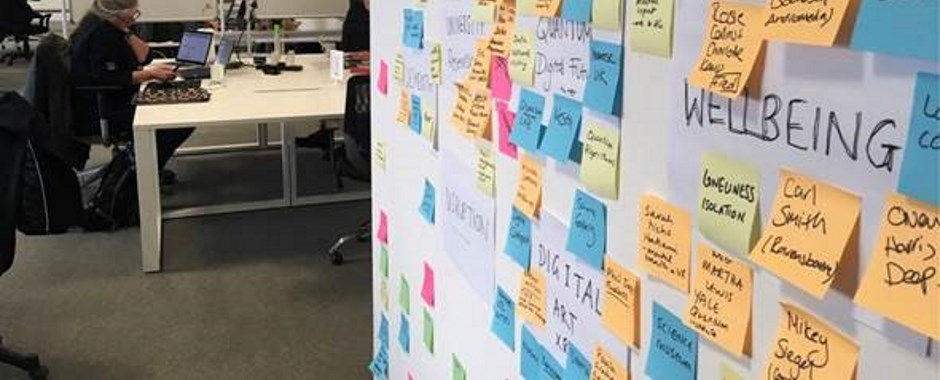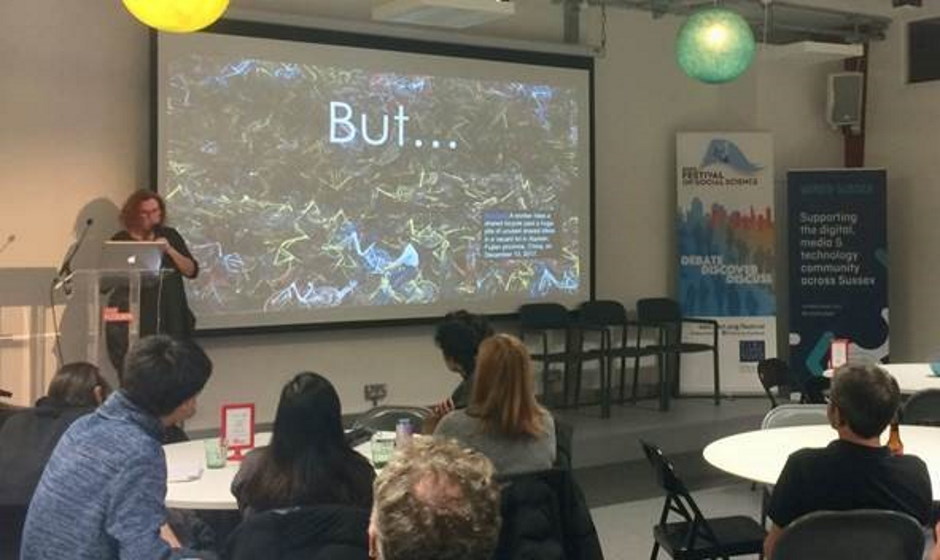by Adrian Smith, Adrian Ely and Phil Jones
When Knowle West residents met with artists Paul Hurley and Caleb Parking in 2016, they had little idea they were at the vanguard of grassroots innovation and doing ‘digital’ differently. The meeting was at Knowle West Media Centre (KWMC), a community-based space in Bristol that uses arts and technology to help people find creative solutions to their problems, and develop new ways of doing things together.
At the meeting, participants mapped out local issues important to them, and identified the people and organisations involved. One group, concerned about problems with damp in private rented accommodation, went on to help pioneer what became known as the Bristol Approach to Citizen Sensing.
Turning damp into data
With residents at its core, the ‘Damp-busters’ group enrolled technologists and other specialists into co-creating a digital monitoring kit for measuring damp in their homes. Carefully framing the issue, they made use of assets already available to people – such as knowledge about their home, KWMC’s resources for building technological capabilities with people, and an understanding that data was an increasingly powerful gatekeeper for action on social issues.
In creating their own data about damp, Dampbusters codified their concerns into a form more likely to persuade landlords and local authorities to act. Importantly, in building together a Frog Sensor to measure humidity and temperature, and mobilising their data as a group, residents transformed an individual problem into a more powerful collective concern.
This isn’t the usual way to ‘do digital’ that’s favoured by investment and markets. Conventional models in digital tend to prioritise a linear approach around individual leaders (“founder worship”), a Venture Capital-based investment model, a high financial valuation, and market dominance through fast and aggressive scaling. But the search for innovation alternatives is important because these dominant models, popularised in Silicon Valley and beloved of policy elites, have often resulted in the increased concentration of power and resources, and in community alienation.
At a time when it’s clear that society needs better ways of solving its problems, examples like the Bristol Approach point to more hopeful ways of doing innovation.
Learning from the grassroots
We heard about the Bristol Approach from KWMC Director Carolyn Hassan, who joined us for an event we organised at Fusebox in Brighton as part of the ESRC Festival of Social Science. The event aimed to bring social research into grassroots innovation together with creative digital practitioners in Brighton. Together, we wanted to explore socially-committed alternatives to the start-up models currently beloved of many funders and investors.

We spent the afternoon with Brighton-based digital developers, exploring their experiences with innovation, grassroots activism, and social movements for change. And in the evening, we opened to a public discussion, where we heard more from Carolyn and also Jenni Lloyd from Nesta.
What could we learn from the multitude of community-based innovation initiatives that, over decades, have been seeking development alternatives? With thanks to all the participants, here are a few of our reflections …
1. Innovation where it matters
Recognising and encouraging digital innovation capabilities amongst grassroots groups, located away from traditional centres of innovation, opens up possibilities for developing technology according to more plural values, starting with different assumptions, and involving people creatively in specific situations.
But the crucial skills and capabilities here are not only tech ones – they’re community ones. This means the skilful cultivation of methods for active listening, empathy towards situations, mapping issues, dialogue around the ways that problems are framed, and reaching common ground on what people can do together creatively.
Carolyn showed us how this is critically important before, during and after any drawing of digital technology into the co-creation process. And cultivating these capabilities takes time: slowing down and taking care, rather than “moving fast and breaking things”.
2. Ownership and value
At our event, we also heard from Jenni Lloyd at Nesta, who shared her reflections about their Sharelab programme, also launched in 2016. At that time, there was much excitement about new forms of collaboration and sharing through digital platforms. But this risked being eclipsed by concerns about the social consequences of Silicon Valley models for rentier platforms monopolising markets in gig economies. Sharelab wanted to support digital platform models that would be committed to deepening social collaboration, rather than exploiting alienation.

The projects that Sharelab helped ranged from coordinating accommodation for struggling families, networks for re-using furniture, training out of homelessness, sharing surplus breast milk, and innovative approaches to social care.
Jenni argued that sustaining such initiatives, and learning long-term from their many successes and failures, required the organisation of new ownership models capable of realising and rewarding the value created. She pointed to platform cooperativism as an example. Platform cooperatives are owned by the multiple stakeholders, from developers to users, who contribute to the value of the platform service and share in that value through mutually agreed arrangements. This innovative idea would have been familiar to the Rochdale Pioneers in 1844, but it’s been updated with 21st century technological possibilities. Public resources can help with upfront investment in platform cooperatives, and even be an important client of such platforms.
3. From venturing to commoning
Inspiring as Carolyn and Jenni were, their examples barely touch upon the myriad alternatives and possibilities coming from the grassroots.
Some of these solutions will generate business opportunities and livelihoods for participants; others strengthen communities through providing ways of developing technology in a participatory way, and data sovereignty; and all address issues that matter to those communities, over and above the narrower interests of Silicon Valley style investors.
The crucial feature all these models have in common is how each contributes recursively to a wider set of possibilities. For example, the Bristol Approach project produces and takes control of data, but it’s also accompanied by resources and processes for sharing its methods for others, so they can adapt (as has happened in other European cities) and produce their own data, and seek a more empowered voice in local developments.
What’s more, specific initiatives like the Bristol Approach are often part of a broader range of community activities, at KWMC and elsewhere, committed to building more locally owned and co-designed digital ecosystems, where knowledge, solutions and skills are grown within and for the community. Specific grassroots initiatives might come and go with the vicissitudes of funding, volunteer energy, or purpose – but each contributes to a more general orientation that sustains a culture for doing digital differently.
4. Working at different levels: initiatives and wider transformations
Our own contribution to the event drew upon our research finding that grassroots innovation movements operate on different levels. For instance, many grassroots participants work on the level of specific issues and solutions (like those described above); but others, particularly the activists that help these capabilities to circulate in common, are motivated by commitments to a deeper level of transformation, around issues like data sovereignty, innovation democracy, sustainability, or seeing technology as commons.
Recognising and resourcing the value of commoning in technology involves struggle – with funders, with evaluators, with investors, and against predatory encroachments. That is because, ultimately, it involves a deeper redistribution of capabilities: the capability to challenge power by redefining and redistributing political and economic resources to these initiatives.
Much of the struggle to provide a common infrastructure, know-how and opportunities to do digital differently is born of broader motivations and struggles. Having such capabilities in common is important for democracy, because it expands people’s voice, rights and control in relation to the technologies that shape our worlds.
